View in other NatureServe Network Field Guides
NatureServe
Montana
Utah
Wyoming
Idaho
Wisconsin
British Columbia
South Carolina
Yukon
California
New York
Northern Montane Shrew - Sorex obscurus
Other Names:
Dusky or Montane Shrew,
Sorex monticolus
Native Species
Global Rank:
G5
State Rank:
S5
(see State Rank Reason below)
Agency Status
USFWS:
USFS:
BLM:
External Links
State Rank Reason (see State Rank above)
Species is relatively common within suitable habitat and widely distributed across portions of the state
General Description
Pacific coast: pelage gray brown; median tine on anteriomedial edge of I1 usually large and robust; tail indistinctly bicolored; 5 or 6 pairs of friction pads on second to fourth digits of hind feet; level of pigmentation above level of median tine on I1; body size small to medium; U5 triangular, body of U1s not touching, P4 overlapping U5; zygomatic process of maxillary pointed (Carraway 1990).
Diagnostic Characteristics
See Carraway (1995) for a key to western North American soricids based primarily on dentaries.
Species Range
Montana Range
Range Descriptions

 Native
Native
Observations in Montana Natural Heritage Program Database
Number of Observations: 349
(Click on the following maps and charts to see full sized version)
Map Help and Descriptions
Relative Density
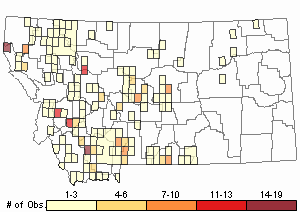
Recency
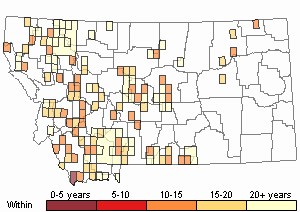
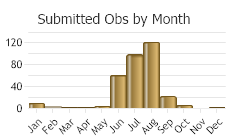
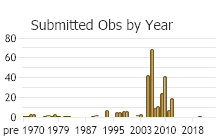
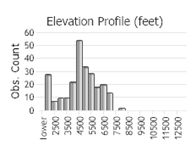 (Observations spanning multiple months or years are excluded from time charts)
(Observations spanning multiple months or years are excluded from time charts)
Migration
Non-migratory.
Habitat
In western Montana, high altitude spruce-fir forest, alpine tundra. Also as low as 3000 ft. in mid-altitude forests. Occurs along streams and rivers east of Continental Divide and in isolated mountain ranges in central Montana (Hennings and Hoffmann 1977).
National Vegetation Classification System Groups Associated with this Species
Alpine
Alpine - Vegetated
Forest and Woodland
Deciduous Forest and Woodland
Low Elevation - Xeric Forest and Woodland
Montane - Subalpine Forest and Woodland
Shrubland
Foothills - Montane Shrubland
Sagebrush Shrubland
Grassland
Lowland - Prairie Grassland
Montane - Subalpine Grassland
Wetland and Riparian
Alkaline - Saline Wetlands
Alpine Riparian and Wetland
Peatland
Riparian and Wetland Forest
Riparian Shrubland
Wet Meadow and Marsh
Recently Disturbed or Modified
Harvested Forest
Insect-Killed Forest
Human Land Use
Agriculture
Developed
Food Habits
Similar to other long-tailed shrews: eats mostly invertebrates (van Zyll de Jong 1983).
Ecology
Non-breeders territorial. Breeders apparently not territorial (van Zyll de Jong 1983).
Reproductive Characteristics
First-year animals may not be reproductively active (van Zyll de Jong 1983).
Stewardship Responsibility
References
- Literature Cited AboveLegend:
 View Online Publication
View Online Publication Carraway, L.N. 1990. A morphologic and morphometric analysis of the 'Sorex vagrans species complex' in the Pacific coast region. Texas Tech Univ. Mus. Spec. Publ. (32): 1-76.
Carraway, L.N. 1990. A morphologic and morphometric analysis of the 'Sorex vagrans species complex' in the Pacific coast region. Texas Tech Univ. Mus. Spec. Publ. (32): 1-76. Carraway, L.N. 1995. A key to recent Soricidae of the western United States and Canada based primarily on dentaries. Occasional Papers of the Natural History Museum, University of Kansas (175):1-49.
Carraway, L.N. 1995. A key to recent Soricidae of the western United States and Canada based primarily on dentaries. Occasional Papers of the Natural History Museum, University of Kansas (175):1-49. Hennings, D. and R.S. Hoffmann. 1977. A review of the taxonomy of the Sorex vagrans species complex from western North America. Occasional Papers of the Museum of Natural History, the University of Kansas. 68: 1-35.
Hennings, D. and R.S. Hoffmann. 1977. A review of the taxonomy of the Sorex vagrans species complex from western North America. Occasional Papers of the Museum of Natural History, the University of Kansas. 68: 1-35. Van Zyll de Jong, C.G. 1983. Handbook of Canadian mammals. 1. Marsupials and insectivores. National Museum of Natural Sciences, National Museums of Canada, Ottawa, Canada. 210 pp.
Van Zyll de Jong, C.G. 1983. Handbook of Canadian mammals. 1. Marsupials and insectivores. National Museum of Natural Sciences, National Museums of Canada, Ottawa, Canada. 210 pp.
- Additional ReferencesLegend:
 View Online Publication
View Online Publication
Do you know of a citation we're missing?
- Web Search Engines for Articles on "Northern Montane Shrew"
- Additional Sources of Information Related to "Mammals"





